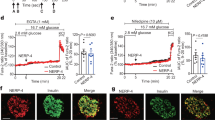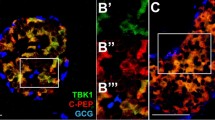Abstract
Nutrients and growth hormones promote insulin production and the proliferation of pancreatic β-cells. An imbalance between ever-increasing metabolic demands and insulin output causes diabetes. Recent evidence indicates that β-cells enhance insulin gene expression depending on their secretory activity. This signalling pathway involves a catalytically inactive receptor tyrosine phosphatase, ICA512, whose cytoplasmic tail is cleaved on glucose-stimulated exocytosis of insulin secretory granules and then moves into the nucleus, where it upregulates insulin transcription. Here, we show that the cleaved cytosolic fragment of ICA512 enhances the transcription of secretory granule genes (including its own gene) by binding to tyrosine phosphorylated signal transducers and activators of transcription (STAT) 5 and preventing its dephosphorylation. Sumoylation of ICA512 by the E3 SUMO ligase PIASy, in turn, may reverse this process by decreasing the binding of ICA512 to STAT5. These findings illustrate how the exocytosis of secretory granules, through a retrograde pathway that sustains STAT activity, converges with growth hormone signalling to induce adaptive changes in β-cells in response to metabolic demands.
This is a preview of subscription content, access via your institution
Access options
Subscribe to this journal
Receive 12 print issues and online access
$209.00 per year
only $17.42 per issue
Buy this article
- Purchase on Springer Link
- Instant access to full article PDF
Prices may be subject to local taxes which are calculated during checkout








Similar content being viewed by others
References
Goodge, K. A. & Hutton, J. C. Translational regulation of proinsulin biosynthesis and proinsulin conversion in the pancreatic β-cell. Semin. Cell. Dev. Biol. 11, 235–242 (2000).
Welsh, M., Nielsen, D. A., MacKrell, A. J. & Steiner, D. F. Control of insulin gene expression in pancreatic β-cells and in an insulin-producing cell line, RIN-5F cells. II. Regulation of insulin mRNA stability. J. Biol. Chem. 260, 13590–13594 (1985).
Leibiger, I. B., Leibiger, B., Moede, T. P. & Berggren, O. Exocytosis of insulin promotes insulin gene transcription via the insulin receptor/PI-3 kinase/p70 s6 kinase and CaM kinase pathways. Mol. Cell. 1, 933–938 (1998).
Kennedy, H. J., Rafiq, I., Pouli, A. E. & Rutter, G. A. Glucose enhances insulin promoter activity in MIN6 β-cells independently of changes in intracellular Ca2+ concentration and insulin secretion. Biochem. J. 342, 275–280 (1999).
Wicksteed, B., Alarcon, C., Briaud, I., Lingohr, M. K. & Rhodes, C. J. Glucose-induced translational control of proinsulin biosynthesis is proportional to preproinsulin mRNA levels in islet β-cells but not regulated via a positive feedback of secreted insulin. J. Biol. Chem. 278, 42080–42090 (2003).
Otani, K. et al. Reduced β-cell mass and altered glucose sensing impair insulin-secretory function in βIRKO mice. Am. J. Physiol. Endocrinol. Metab. 286, E41–E49 (2004).
Trajkovski, M. et al. Nuclear translocation of an ICA512 cytosolic fragment couples granule exocytosis and insulin expression in β-cells. J. Cell Biol. 167, 1063–1074 (2004).
Lan, M. S., Lu, J., Goto, Y. & Notkins, A. L. Molecular cloning and identification of a receptor-type protein tyrosine phosphatase, IA-2, from human insulinoma. DNA Cell Biol. 13, 505–514 (1994).
Zahn, T. R., Macmorris, M. A., Dong, W., Day, R. & Hutton, J. C. IDA-1, a Caenorhabditis elegans homolog of the diabetic autoantigens IA-2 and phogrin, is expressed in peptidergic neurons in the worm. J. Comp. Neurol. 429, 127–143 (2001).
Magistrelli, G., Toma, S. & Isacchi, A. Substitution of two variant residues in the protein tyrosine phosphatase-like PTP35–IA-2 sequence reconstitutes catalytic activity. Biochem. Biophys. Res. Commun. 227, 581–588 (1996).
Saeki, K. et al. Targeted disruption of the protein tyrosine phosphatase-like molecule IA-2 results in alterations in glucose tolerance tests and insulin secretion. Diabetes 51, 1842–1850 (2002).
Harashima, S, Clark, A., Christie, M. R. & Notkins, A. L. The dense core transmembrane vesicle protein IA-2 is a regulator of vesicle number and insulin secretion. Proc. Natl Acad. Sci. USA 102, 8704–8709 (2005).
Solimena, M. et al. ICA 512, an autoantigen of type I diabetes, is an intrinsic membrane protein of neurosecretory granules. EMBO J. 15, 2102–2114 (1996).
Hermel, J. M., Dirkx, R. & Solimena, M. Post-translational modifications of ICA512, a receptor tyrosine phosphatase-like protein of secretory granules. Eur. J. Neurosci. 11, 2609–2620 (1999).
Ort, T. et al. Dephosphorylation of β2-syntrophin and Ca2+–μ-calpain-mediated cleavage of ICA512 upon stimulation of insulin secretion. EMBO J. 20, 4013–4023 (2001).
Knoch, K. P. et al. Polypyrimidine tract-binding protein promotes insulin secretory granule biogenesis. Nature Cell Biol. 6, 207–214 (2004).
Knoch, K. P. et al. cAMP-dependent phosphorylation of PTB1 promotes the expression of insulin secretory granule proteins in β-cells. Cell Metab. 3, 123–134 (2006).
Levy, D. E. & Darnell, J. E. Jr. Stats: transcriptional control and biological impact. Nature Rev. Mol. Cell Biol. 3, 651–662 (2002).
Nielsen, J. H. et al. Regulation of β-cell mass by hormones and growth factors. Diabetes 50, S25–S29 (2001).
Brelje, T. C., Stout, L. E., Bhagroo, N. V. & Sorenson, R. L. Distinctive roles for prolactin and growth hormone in the activation of signal transducer and activator of transcription 5 in pancreatic islets of Langerhans. Endocrinology 145, 4162–4175 (2004).
Weinhaus, A. J., Stout, L. E. & Sorenson, R. L. Glucokinase, hexokinase, glucose transporter 2, and glucose metabolism in islets during pregnancy and prolactin-treated islets in vitro: mechanisms for long term up-regulation of islets. Endocrinology 137, 1640–1649 (1996).
Friedrichsen, B. N. et al. Signal transducer and activator of transcription 5 activation is sufficient to drive transcriptional induction of cyclin D2 gene and proliferation of rat pancreatic β-cells. Mol. Endocrinol. 17, 945–958 (2003).
ten Hoeve, J. et al. Identification of a nuclear Stat1 protein tyrosine phosphatase. Mol. Cell. Biol. 22, 5662–5668 (2002).
Galsgaard, E. D. et al. Identification of a growth hormone-responsive STAT5-binding element in the rat insulin 1 gene. Mol. Endocrinol. 10, 652–660 (1996).
Rodriguez, M. S., Dargemont, C. & Hay, R. T. SUMO-1 conjugation in vivo requires both a consensus modification motif and nuclear targeting. J. Biol. Chem. 276, 12654–12659 (2001).
Johnson, E. S. & Gupta, A. A. An E3-like factor that promotes SUMO conjugation to the yeast septins. Cell 106, 735–744 (2001).
Melchior, F., Schergaut, M. & Pichler, A. SUMO: ligases, isopeptidases and nuclear pores. Trends Biochem. Sci. 28, 612–618 (2003).
Uchimura, Y., Nakamura, M., Sugasawa, K., Nakao, M. & Saitoh, H. Overproduction of eukaryotic SUMO-1 and SUMO-2-conjugated proteins in Escherichia coli. Anal. Biochem. 331, 204–206 (2004).
Sarmiento, M., Zhao, Y., Gordon, S. J. & Zhang, Z. Y. Molecular basis for substrate specificity of protein-tyrosine phosphatase 1B. J. Biol. Chem. 273, 26368–26374 (1998).
Drake, P. G., Peters, G. H., Andersen, H. S., Hendriks, W. & Møller N. P. A novel strategy for the development of selective active-site inhibitors of the protein tyrosine phosphatase-like proteins islet-cell antigen 512 (IA-2) and phogrin (IA-2β). Biochem. J. 373, 393–401 (2003).
Berg, K. L., Siminovitch, K. A. & Stanley, R. E. SHP-1 regulation of the p62DOK tyrosine phsophorylation in macrophages. J. Biol. Chem. 274, 35855–35865 (1999).
Felberg, J. et al. Subdomain X of the kinase domain of Lck binds CD45 and facilitates dephosphorylation. J. Biol. Chem. 279, 3455–3462 (2004).
Aoki, N. & Matsuda, T. A nuclear protein tyrosine phosphatase TC-PTP is a potential negative regulator of the PRL-mediated signaling pathway: dephosphorylation and deactivation of signal transducer and activator of transcription 5a and 5b by TC-PTP in nucleus. Mol. Endocrinol. 16, 58–69 (2002).
Chen, Y. et al. Identification of Shp-2 as a Stat5A phosphatase. J. Biol. Chem. 278, 16520–16527 (2003).
Gu, F. et al. Protein tyrosine phosphatase 1B attenuates growth hormone-mediated JAK2-STAT signaling. Mol. Cell Biol. 23, 3753–3762 (2003).
Liu, B. et al. Inhibition of Stat1-mediated gene activation by PIAS1. Proc. Natl Acad. Sci. USA 95, 10626–10631 (1998).
Ungureanu, D. et al. PIAS proteins promote SUMO-1 conjugation to STAT1. Blood 102, 3311–3313 (2003).
Matsuoka, T., Zhao, L. & Stein, R. The DNA binding activity of the RIPE3b1 transcription factor of insulin appears to be influenced by tyrosine phosphorylation. J. Biol. Chem. 276, 22071–22076 (2001).
Kishi, A. et al. Sumoylation of Pdx1 is associated with its nuclear localization and insulin gene activation. Am. J. Physiol. Endocrinol. Metab. 284, E830–E840 (2003).
Drucker, D. J. Glucagon-like peptides: regulators of cell proliferation, differentiation, and apoptosis. Mol. Endocrinol. 17, 161–171 (2003).
Melloul, D., Marshak, S. & Cerasi, E. Regulation of insulin gene transcription. Diabetol. 45, 309–326 (2002).
Horikawa, Y. et al. Genetic variation in the gene encoding calpain-10 is associated with type 2 diabetes mellitus. Nature Genet. 26, 163–175 (2000).
Cox, N. J., Hayes, M. G., Roe, C. A., Tsuchiya, T. & Bell, G. I. Linkage of calpain 10 to type 2 diabetes: the biological rationale. Diabetes 53, S19–S25 (2004).
Zhou, Y. P. et al. A 48-hour exposure of pancreatic islets to calpain inhibitors impairs mitochondrial fuel metabolism and the exocytosis of insulin. Metabolism 52, 528–534 (2003).
Marshall, C. et al. Evidence that an isoform of calpain-10 is a regulator of exocytosis in pancreatic β-cells. Mol. Endocrinol. 19, 213–224 (2005).
Asfari, M. et al. Establishment of 2-mercaptoethanol-dependent differentiated insulin-secreting cell lines. Endocrinol. 130, 167–178 (1992).
Gotoh, M., Maki, T., Kiyoizumi, T., Satomi, S. & Monaco, A. P. An improved method for isolation of mouse pancreatic islets. Transplantation 40, 437–438 (1985).
Ort, T. et al. The receptor tyrosine phosphatase-like protein ICA512 binds the PDZ domains of β2-syntrophin and nNOS in pancreatic β-cells. Eur. J. Cell Biol. 79, 621–630 (2000).
Schmidt, D. & Muller, S. Members of the PIAS family act as SUMO ligases for c-Jun and p53 and repress p53 activity. Proc. Natl Acad. Sci. USA 99, 2872–2877 (2002).
Williams C. C. et al. The ERBB4–HER4 receptor tyrosine kinase regulates gene expression by functioning as a STAT5A nuclear chaperone. J. Cell Biol. 167, 469–478 (2004).
Acknowledgements
We are grateful to P. De Camilli, M. Matteoli and M. Zerial for critical reading of the manuscript; A. Barthel, R. Grosschedl, R. Janknech, F. White and H. Saitoh for reagents; F. Ehehalt, K. Erdmann and M. Jäger for help in islet isolation; K. Pfriem for excellent assistance; and G. Nikolova and all members of the Solimena lab for advice. This work was supported by funds from the Alexander von Humboldt Foundation, the German Ministry for Education and Research (BMBF), the European Foundation for the Study of Diabetes and the Juvenile Diabetes Research Foundation to M.S., and a MedDrive Grant from the Medical School of Dresden Univsity of Technology to H.M. and M.T.
Author information
Authors and Affiliations
Corresponding author
Ethics declarations
Competing interests
The authors declare no competing financial interests.
Supplementary information
Supplementary Information
Supplementary Figures S1, S2, S3 and S4 Original Images 1 and 2 (PDF 345 kb)
Rights and permissions
About this article
Cite this article
Mziaut, H., Trajkovski, M., Kersting, S. et al. Synergy of glucose and growth hormone signalling in islet cells through ICA512 and STAT5. Nat Cell Biol 8, 435–445 (2006). https://doi.org/10.1038/ncb1395
Received:
Accepted:
Published:
Issue Date:
DOI: https://doi.org/10.1038/ncb1395
This article is cited by
-
Common and female-specific roles of protein tyrosine phosphatase receptors N and N2 in mice reproduction
Scientific Reports (2023)
-
SENP2 regulates mitochondrial function and insulin secretion in pancreatic β cells
Experimental & Molecular Medicine (2022)
-
Both conditional ablation and overexpression of E2 SUMO-conjugating enzyme (UBC9) in mouse pancreatic beta cells result in impaired beta cell function
Diabetologia (2018)
-
Novel prokaryotic expression of thioredoxin-fused insulinoma associated protein tyrosine phosphatase 2 (IA-2), its characterization and immunodiagnostic application
BMC Biotechnology (2016)
-
CISH has no non-redundant functions in glucose homeostasis or beta cell proliferation during pregnancy in mice
Diabetologia (2013)



